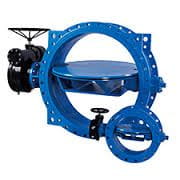Basic Knowledge of Flanged Butterfly Valve
1. Novel design, small size and light weight.
2. A butterfly plate has double-eccentric-pivoted structure, which we can open and close quickly and easily handle without too many efforts.
3. No sliding friction between butterfly plate and sealing ring. The sealing surface is wear-resistant. It has the advantages of long service life, reliable sealing performance and easy adjustment.
Bidirectional sealing
Generally, traditional butterfly valves can not seal very well under the negative direction working pressure. Currently, there are no mandatory provisions for bidirectional sealing in the national relative standards due to the following reasons:
1.Adopt the self sealing design concept
The valve clack sealing ring directly zigzag in valve clack by the rubber, instead of fixing by pressing ring or bolt. Thus avoiding the problems of bolt looseness and premature failure of the sealing ring due to uneven distributed loads. The sealing ring will produce the self-seal force under the function of negative direction working pressure and increase the sealing pressure, causing the sealing ring to press tightly on the valve seat. The bigger working pressure is, the stronger the self-sealing force will be. It makes the sealing ring connect tightly with the valve seat and reach the bidirectional sealing effect.
2.The valve clack has good rigidity and is not easy to deform
For the butterfly valve above DN300, its valve clack have the parallel plate truss currency structure. It features in small flow resistance, good rigidness and uneasy deformation under the negative direction working pressure. It makes the sealing ring not leave the best sealing point of the sealing valve with the deformation of the valve clack and guarantee the sealing performance of the sealing ring.
(1)When adopting the self-sealing design concept, the small interference between rubber ring and stainless steel valve seat is just to maintain the initial sealing condition. Thus the pressure for sealing is increased with the increasing system pressure.
(2) In addition, there is a so called “breath” groove for elastic concession of rubber in the zigzag groove, which makes the rubber have enough space for expanding and contracting when it is under stress. Thus the rubber won’ t have elastic fatigue in the long working time and the service life of the sealing ring is much longer than the traditional type.
Patented design: taper pin structure
Generally, the flanged butterfly valve adopts the traditional pin connection that the pin passes through the valve shaft, not only reducing the strength of valve shaft, but also leading to the gap between the pin and the valve shaft in the long-term use process. It causes the impulse load when we open and close the valves, which far exceeds the load caused by crushing and shearing stress in the normal situation. It finally makes the pin to be seriously deformed or broken, the valve to be invalid or to loosely shut down and shortens the service life of valves. If the pin connection between valve clack and valve shaft is replaced with the taper pin of the American design patent, the taper pin will not pass through the shaft center and not reduce the strength of shaft. It will greatly enlarge the faying surface of valve shaft. By tightening the nuts of taper pin, it will produce pretightening force between the taper pin and the valve shaft, making the clack closely connected with the shaft without a little gap. When open or close the valve, it will not produce any impulse load, so the valve clack will turn stably and finally realize the reliable sealing.
Unique axial adjustment locking device at the bottom
For the butterfly valves with specification above DN300, considering the reliability of butterfly plate sealing, locates the valve clack in the position with its best sealing performance by accurate adjustment and fixation of axial position. For valve clack droop resulted in the long-term service, you can further adjust and fasten the device to achieve the result of free leakage.
Convenient replacement of sealing rings
When change the sealing ring, it is unnecessary to dismantle the valve clack. It only needs to completely open the valve, and then take out the key of the operating gear, making the operating gear adjusted to the closing state and connected with the main valve key. When continue to turn the hand wheel toward the opening direction, you can replace the sealing ring until the sealing ring arrives at the opposite side of the valve sealing surface.
